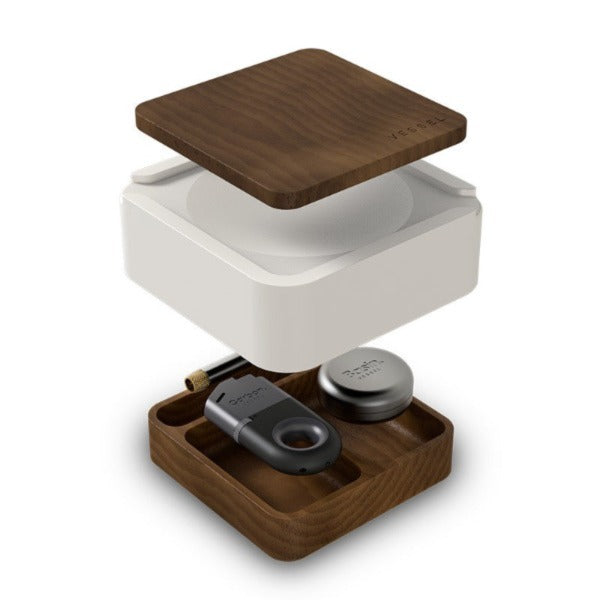Inspect your cannabis under the light and you’ll notice snow-like dust caked on the inside and outside of the flower. This sticky resin is made up of hundreds of crystals, or trichomes, which are responsible for housing the psychoactive and aromatic elements of marijuana.
The reason budtenders and harvesters handle the cannabis plant with such care has everything to do with trichomes. Preserving the sticky texture is an important factor in THC content, which is why professionals wear gloves to maintain trichome density—otherwise known as ‘sticky icky.’
Besides making marijuana more potent, trichomes perform a variety of other functions, all of them vital to the plant’s survival.
What are trichomes and what is their function?
It may surprise you to know that trichomes are found on many species of plants, lichens, and algae, not just cannabis and hemp. Trichomes repel plant-eating insects and animals because of their bitter taste.
Plants are susceptible to other stressors such as excessive light/temperature, wind, and disease. Trichomes, in a way, defend and protect plants like an army of green soldiers.
Specifically for cannabis, trichomes provide clues about plant maturation. When trichomes change from translucent to cloudy white, it’s usually a good indicator that it’s time to harvest. To ensure peak THC levels, the standard followed by most harvesters is to track trichome coloration.
In addition to helping cannabis/hemp plants ward off pests, disease, and damage from fluctuating outside conditions, trichomes produce cannabinoids and terpenes in their mushroom-like appendages.
Common types of cannabinoids and terpenes are:
Cannabinoids: THC, CBD, CBN, CBG, THC-V
Terpenes: Myrcene, linalool, caryophyllene, pinene
Research continues to support thetherapeutic benefits of cannabinoids and terpenes. People report relief from pain, anxiety, and sleep with the use of cannabis/hemp. These findings underscore just how important trichomes are for future medicinal treatments.
Types of trichomes on cannabis
Of the many types of trichomes, here are the three most popular kinds found on cannabis:
Capitate-stalked trichomes: These 50-100 micrometer-wide trichomes tend to be the ones people see the most. You don’t need a microscope to get a look at capitate-stalked trichomes, because they’re larger and easily recognizable to the naked eye. ‘Capitate’ refers to the round-shaped head of trichome glands.
Capitate-stalked trichomes are generally associated withhigh cannabinoid levels. They’re the ones to keep an eye out for during plant maturation, as the glands change from translucent to milky to amber. For the most part, milky trichomes are the preferred standard for ready-to-harvest buds.
Capitate sessile trichomes: At 20-30 micrometers, capitate sessile trichomes have a head and a stalk, although they’re not as easy to see as capitate-stalked trichomes.
Bulbous trichomes: Tiny and invisible without a microscope, bulbous trichomes measure at about 10-15 micrometers high. They’re found all over the surface of the plant but only amount to a handful of cells.
Why should you care about trichomes on your cannabis?
In case you’re wondering why any of this matters, we’ve taken the liberty to breakdown this subject even further. Here’s why you should care about trichomes:
Trichome density
Depending on the extraction method, denser trichomes can result in higher THC content. Producing concentrates, for example, calls for a solvent or solventless method of extracting cannabinoids and terpenes from the oily trichome glands. This process isolates trichomes from the flower, and as a result, produces high cannabinoid/terpene yields.
A simple way to enjoy trichomes at home, though, is to collect ‘kief’ in your grinder. This small collection of what appears to be dust carries potent THC. The grinder filters the resin to the bottom, and eventually, you’ll have enough to sprinkle on top of bowls or joints.
Popular strains that produce a lot of kief are White Widow, Sour Diesel, and OG Kush.
On the other hand, researchers are also interested in understanding how toreduce THC in trichomes. This opens up opportunities for more people to enjoy the non-intoxicating effects of hemp, while still retaining the medicinal benefits of CBD.
Trichomes and terpenes
Terpenes are the aromatic element of cannabis/hemp, although they also offer therapeutic benefits. Pine, musk, diesel, lemon, and wood are common descriptions used to describe the aroma wafting off of dried herb. Trichomes produce terpenes in the mushroom-shaped head of the stalk.
That said, vapingenhances the taste of cannabis due to the way it preserves trichome and terpene presence during extraction. For this reason, you may find vaping more favorable than smoking flower if you’re looking to satisfy your palate.
Trichomes and cultivation
Finally, people growing marijuana at home should pay attention to trichomes. As your buds bloom, the trichomes can tell you if your plant is ready to be harvested. Look for a milky-white color in the trichomes.
This color indicates peak cannabinoid and terpene levels. Professional growers also note a difference in trichome color between Indica and Sativa strains. In general, harvesting Sativas requires both translucent and amber-colored trichome heads—where amber represents a plant at full maturation. For Indicas, stick to translucent, milky trichomes for classic ‘couch-lock’ highs.
To sum it up
The attractive, glittery sheen that makes cannabis so irresistible happens to be responsible for thesynthesis of cannabinoids and terpenes. Although trichome production is strain-specific and dependent on light, you can expect stronger highs from buds rich in resin—the frostier the better.
Remember to always handle your buds with care to preserve trichome density and quality. Hopefully by now, you have a newfound appreciation for trichomes, as this glorious sparkly goo is the reason cannabis/hemp tastes, smells, and looks so delectable.
FAQs
Do trichomes get you high?
Trichomes are involved in cannabinoid synthesis. The sense of euphoria associated with THC is due to trichome density. So, when you smoke cannabis, you get high because of what’s inside trichomes. Without trichomes, there are no cannabinoids or terpenes.
What do trichomes contain?
Cannabinoids such as THC and CBD are found within trichome bulbs. Trichomes also produce terpenes, the fragrant component of cannabis or hemp. Don’t be fooled by their small size, because trichomes contain potent ingredients with strong effects.








Leave a comment (all fields required)